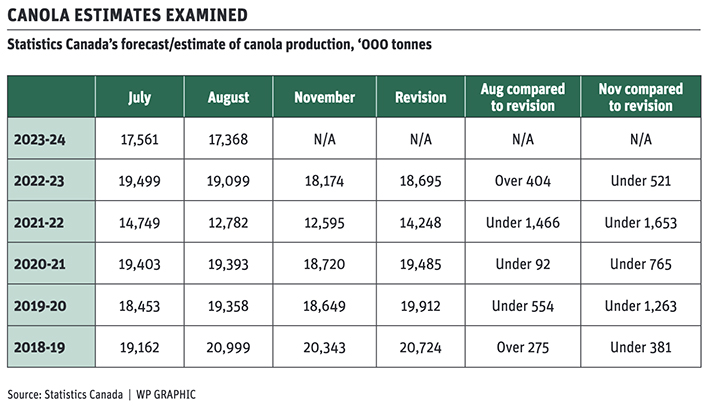Statistics Canada’s August production forecast released Sept. 14 showed mostly only small differences from the July forecast that was issued Aug. 29 and confirmed that dry weather hurt yields leading to a smaller crop than last year.
The report showed declines in durum, canola and barley compared to the July report. The spring wheat number was a little higher than July but still significantly lower than last year.
When Statistics Canada began issuing production forecasts based on satellite imagery, agriculture region weather, Normalized Difference Vegetation Index and computer modelling and ended its farmer survey for the production forecast during the growing season, some were skeptical of their accuracy.
But a scan of the past five years of the agency’s production forecasts and estimates for canola shows the August model-based report to be the forecast that is most accurate compared to the final revised number that Statistics Canada issues following the close of the crop year.
I looked at canola only for this column. I’ll look at other crops in the future.
Statistics Canada does four assessments of production. The July report is issued in late August, the August report comes out in mid-September . These two are based on satellite imagery and modelling. The November report comes out in early December and is based on farmer surveys.
Then, following the crop year end July 31 stocks report that comes out in September, the agency tallies up all the crop disposition — things such as exports, domestic processing and consumption, seed use, losses in handling, animal feed and dockage, ending stocks on farm and in commercial position — and revises the production number.
The idea is that there is a bucket of supply — the carry-in, production and imports — and there is a bucket of disposition — the exports, domestic use and so on. If the disposition is larger than supply, then the supply estimate must be wrong and so the production number is adjusted upward.
In each of the previous five years, the canola revised number was increased relative to the November production report. The biggest increase was for the 2021-22 canola crop, which rose by 1.653 million tonnes compared to November. The smallest change was for the 2018-19 crop, which rose 381,000 compared to the November report.
In each year, the August report was closer to the revised number than the November report.
It will be interesting to look at other crops and see if this surprising accuracy of the August model is repeated.
I saw a social media posting by analyst Chuck Penner of LeftField on durum that shows more variability than what I saw in canola.
But this deeper dive into the numbers should not take attention away from the reality that the canola supply relative to demand is going to be tight this year.
The August forecast is 17.368 million tonnes, down 1.1 percent from the July forecast and down 7.1 percent compared to last year.
In the immediate days after the Sept. 14 Statistics Canada forecast, November canola futures edged higher.

They had been falling since late August on harvest pressure and weakness in soybeans and soy oil.
The soybean supply in the United States is likely going to be the tightest in eight years and so that supports oilseed prices generally, but there was a little weakness in recent weeks as it appears the intense heat wave in late August and early September in the Midwest might not have caused as much yield damage as earlier thought.
Canola’s lift last week was also supported by firmer soy oil futures, supported by West Texas crude oil climbing to US$90 per barrel.
Crude was supported by announcements from Saudi Arabia and Russia that they would extend production cuts they made in summer through to the end of the year.
Only a month ago, many analysts thought crude in the second half of the year would trade around $85 a barrel, but that outlook might need to be adjusted upward.
Stronger crude oil prices support vegetable oil values because a percentage of vegetable oil is made into fuel.
Looking at the other big acreage crop in the Statistics Canada production forecast we see spring wheat at 22.637 million tonnes. That is up 2.4 percent over the July forecast, but is 12.4 percent smaller than last year.
Spring wheat yield is expected to fall by 18.6 percent to 41.2 bushels per acre because of dry conditions, offsetting the 5.6 percent increase in area to 26.3 million acres.
Russia’s expected huge supply and exports of wheat have weighed on the crop’s future’s price since early August, but the supply of quality high protein wheat from Canada, Australia and Argentina is expected to tighten because of production problems and that could wheat prices firm into the autumn.

















